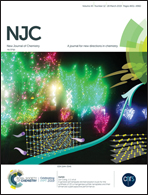Ultrasound-assisted dispersive magnetic solid phase extraction based on metal–organic framework/1-(2-pyridylazo)-2-naphthol modified magnetite nanoparticle composites for speciation analysis of inorganic tin†
Abstract
A new magnetic metal–organic framework (MMOF) constructed from MIL-101(Cr) and 1-(2-pyridylazo)-2-naphthol-modified magnetite nanoparticles was introduced for the ultrasound-assisted magnetic solid phase extraction (UA-MSPE) and speciation analysis of trace amounts of inorganic tin. Ultrasonic irradiation accelerated the mass transfer process in the sorption step and broke the affinity between the analyte and nanoadsorbent in the elution process. The MMOF exhibited high selectivity toward Sn(IV) at pH = 5.8. The Sn(II) concentration was determined after its oxidation to Sn(IV) and extracting total tin. After ultrasound-assisted sorption and elution steps, tin was determined with electrothermal atomic absorption spectrometry (ETAAS). The limit of detection, linear range and precision (RSD%) for Sn(IV) were 5.0 ng L−1, 15–1000 ng L−1 and 7.4%, respectively. The accuracy of the US-MSPE method was confirmed by employing a certified reference material. Finally, the method was utilized successfully for the fast and selective speciation analysis of Sn(IV) and Sn(II) in water and food samples.



 Please wait while we load your content...
Please wait while we load your content...